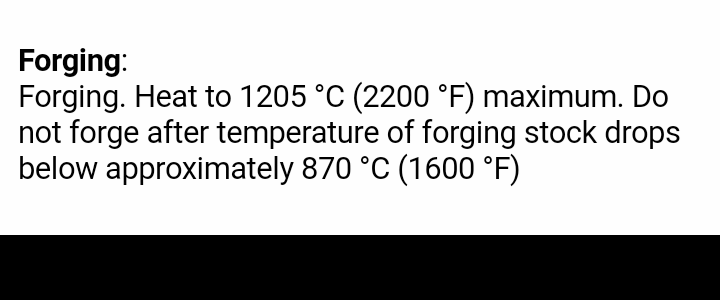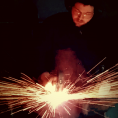-
Posts
733 -
Joined
-
Last visited
Content Type
Profiles
Forums
Articles
Gallery
Downloads
Events
Posts posted by Will W.
-
-
Frosty, he seems to imply that the information he has is from the makers.
On 3/25/2018 at 10:47 AM, ds99 said:i have been using some dama steel and looking at there website and spec sheet the tempering temps seem low around 345 F
That may or may not be low, depending on what youre using it for. Might be just about perfect for a straight razor. Definitely too low for a longsword.
Point is, in order to make a reasonable suggestion, we need to know what youre making.
We cannot make bricks without clay.
-
1 hour ago, Irondragon Forge & Clay said:
A bench grinder is probably the worst for removing stock on knives
I agree, for dressing tools, but for knives, bench grinders work very well for really rough profiling, i usually only use mine for stock removal knives, forged knives are close enough in profile to start on the belt grinder.
Angle grinders also work great, more delicate and precise than a bench grinder, but you cant hog as much material off as you can with a bench grinder, in my experience. Angle grinders are also blood thirsty fiends sent from the pits of Hades, you gotta watch those little demons. First chance you give them, they'll bite.
If knives are your thing, honestly, good files are your friends (i had over 30 last time i counted, no two are the same.) They take longer, yes, but they teach you a lot more about profiles, grinds, bevel angles, etc. And its a lot harder to mess up with files, to the point that it cant be corrected. One slip on a BM2 and, woop, another one in the scrap pile lol. Plus with files, when they wear out, you can turn THEM into knives. Brilliant, really.
-
Thats a good one, holder, i like it.
Nobodies going to tell you that you cant post here. Were not THAT tyrannical.
-
Depends on its exact alloys and intended use. I temper my chef knives at a far lower temperature than my bowies, for example.
2 cycles of 400°F for ~30 minutes each will produce a nice medium hardness/medium toughness blade, its what i do for EDC, hunting, and camp knives, but again, depends on the alloy.
Dont know if you have one or not but get a laser thermometer so you can read the temperature of your steel while its in the oven, toaster ovens are not exactly known for consistent and precise temperatures.
-
Check out the JABOD threads in the solid fuel forge section. JABOD stands for Just A Box Of Dirt and it is an extremely simple, cheap, and effective way to make a forge.
You can make your own charcoal. Honestly, its insanely easy. Its labor intensive, but if you own wooded property, its free. Theres a few threads about charcoal retorts in the solid fuel section.
Then you just need an anvil. Hit a scrap yard, any large piece of steel will do. There are threads in the anvil section about improvised anvils.
Hopefully that gets you pointed in the right direction. Welcome to the addiction! Um, i mean, hobby....
 .
.
-
Sweeeeeet. Congrats, Finn.
-
6 hours ago, iron woodrow said:
They are not in any way original pieces, im sorry to say. They are nicely made but not functional nor are the proportions right at all.
How exactly do you know theyre not original? Im no expert and this is a genuine question.
Looks pretty practical to me. Pretty sure if i put one of those cuisses on and had you whack my leg with a sword, i would walk away just fine.
-
2 hours ago, ThomasPowers said:
Glen; I want a shirt with a pic of a large scrap pile and "Iron Midden" over it in the font Iron Maiden uses!
I second that motion.
-
Anything below .125" but above .04" is usually a good size to start with. Stack as high as your arm can handle, but i personally wouldnt go higher than 2 inch. I actually finished drawing out a 2 inch square damascus billet the other day, what a bear, wont be stacking that high ever again lol!
Length of the billet depends on your forge. Personally, i like to set the entire billet in one heat, so i go between 4 to 5 inches as thats how much metal my forge will get up to welding temp.
Width is subjective, i like 1-1/2 because it leaves me more material to draw out. Too wide and it becomes tricky, you have a lot of lateral hits you must make in order to overlap strikes before moving down the billet, which requires good hammer control. Too narrow and the stack likes to buckle on you, depending on thickness.
-
Nice! I really like the handle, the fit and finish on it looks great, and the sheath fits it very well. I personally would have put a ricasso on the blade, but with that big guard on it, its not necessary.
Great work.
-
If your going to go with titanium, get yourself some nice dark glasses, like the kind used when plasma cutting, #4 shade if my memory serves me. The sparks that titanium throws off when grinding are extremely bright white, nothing like the orange/yellow sparks of steel.
-
The heat treaters guide app in the heat treating section gives you information on forging temperatures for various alloys, some have much smaller windows of opportunity than 5160. In fact, 5160 is quite forgiving in its forging temperatures, compared to some.
What the previously mentioned app says about 5160:

-
I think Stan pretty much covered it. Stainless steel with a synthetic handle. 440c, 154cm, nitro-v, and cpm s90v come to mind as good blade steels.
For a handle, you may be able to use micarta, but im not sure how salt water would affect it, so i would recommend acrylic.
Stainless steel pins and hardware would also be advisable, i would go with a 303 series stainless for them, but ive heard 416 has comparable corrosion resistance if heat treated.
I am not sure how epoxy is affected by salt water and if some are better than others. Worth looking into.
-
Think of all the future craftsman you may currently be inspiring, all the hands that may make beautiful things because of what you showed them. That alone makes it worth it.
Also, that is a wonderful knife for 45 minutes.
-
Im with everybody else, its elegance lies in its simplicity. Nothing complicated, all functional. Looks good.
And i really like that knife, btw. Lines are very clean and that handle is awesome!
-
1 hour ago, Daswulf said:
In my own little opinion ( not that I've ever used a straight razor or know a lot about them) someone that is fanatical enough to use a straight razor would be good enough to care for said razor, and not need Ultra fancy stainless that requires crazy heat treat. I would think a good dry and oiling of the blade would be in the time frame of someone using one. ( could be wrong)
Actually Das, thats a good point, i agree. Its the same thing with carbon steel kitchen knives, ive found. People who want them are willing to care for them.
55 minutes ago, Joël Mercier said:I hope I did not offend you.
Oh believe me Joel, you are going to have to try a lot harder than that if you want to offend me
 . You bring up valid points, and i appreciate you doing so. Also, im almost certain the idea of "too much time" spent reading about steel and knives is a myth.
. You bring up valid points, and i appreciate you doing so. Also, im almost certain the idea of "too much time" spent reading about steel and knives is a myth.
-
Joel
The only reason i didnt recommend aeb-l or nitro-v is because i dont know much about either steel, never worked with them. I have worked with both steels i listed though, and got quite a nice edges on both. Perhaps not razor edges though. I tend to only recommend that which i have worked with myself. Sounds like Aeb-l would make a nice razor, however.
-
What about stainless steels? Typically more complicated on the heat treat, might have to send it off depending on what you go with, but i think i would want stainless for a blade that is almost always going to be damp. 440C or CPM S90V come to mind, both make excellent blades, IMO.
Ive heat treated 440C in my charcoal forge before, and even included a "cryo" cycle with acetone and dry ice, turned out well, its definitely trickier than any 10xx steel, however. Any of the CPM SxxV series steels should be sent out, they are not forgiving.
Of course you could just apply regular carbon steel maintenance techniques and forget the SS.
If thats not something you want to go with, im sure 52100 would do just fine.
-
My fathers boss had an old anvil sitting in the shop, and was apparently never used in the 30+ years my father was working there (and he suspected for longer than that). I had him ask his boss if he would take 100 bucks for it, and he agreed, said it was just taking up space.Turned out to be a 150 pound 1905 Fisher. Its in great shape, and i think it had an easy life, but im now giving it the exercise it deserves
 .
.
-
Well now i REALLY want to quench and break test a tape measure. I mean, who needs the first 4 inches of one anyways?

-
Wow! That thing is a beast! Nice find, its in outstanding shape. Do you have the matching hammer to complete the set?

-
What the other guys said, Jerry. Never quit doing what you love, even if you have to take it a little slower.
-
But its also important to keep in mind that hand hammering takes more heats. Morre heats=more material loss due to scaling. It can be tricky to predict scale loss, so ive found that youre better off adding a little material to compensate.
-
Ive made quite a few axes out of s7, and in my experience, it is quite a tough steel, it dulls faster than some steels, but if HT'd properly, it takes a lot of force to chip it. I was splitting some oak in my shop into kindling with an s7 hatchet i made and i missed my target, absolutely nailed the concrete floor, took a nice little chunk out of the floor but didnt touch the steel.
Take that for what its worth.


UK Knife Law - Updated
in Knife Making
Posted
Thats a classic example, JAV. Guns, knives, hammers, cars, steel bars, pencils, and keyboards are all tools. They all serve a function and have a use. All of them can also be used to harm people. Intention is everything.
I, for one, am enjoying this borderline rule breaking thread and sincerely hope it is allowed to keep going.
I also hope the Northern Irish boy is alright.